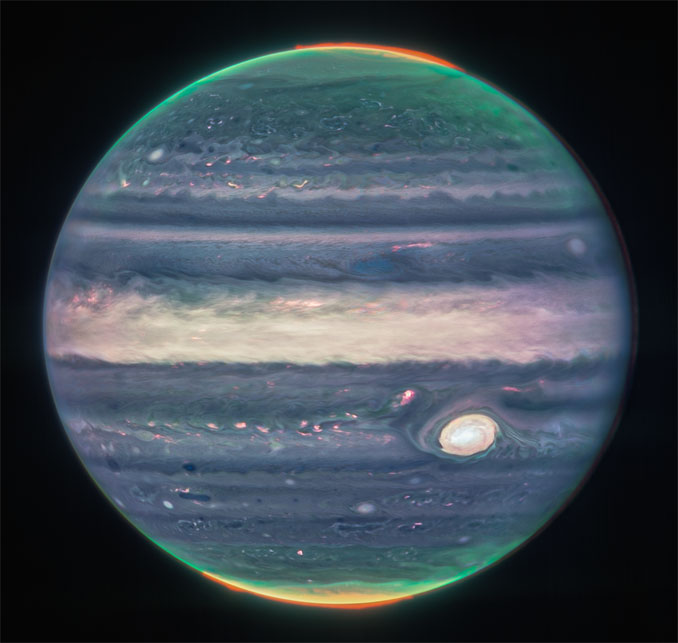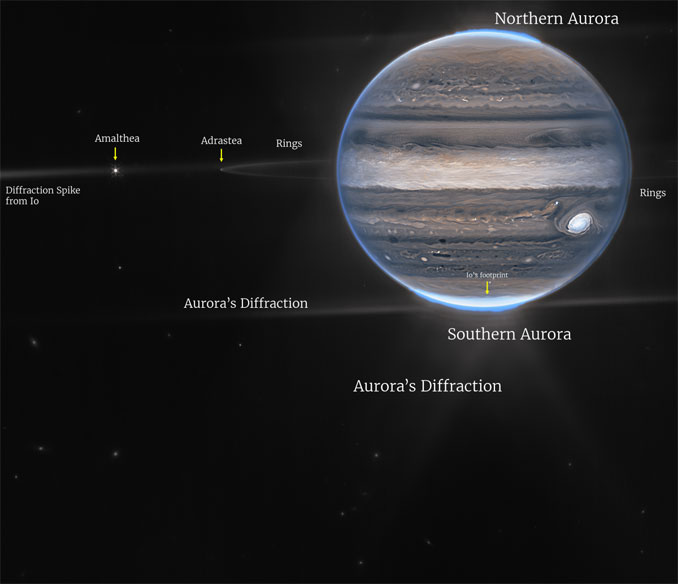
Jupiter is known for its Great Red Spot, giant storms, powerful winds, colorful bands or ribbons, auroras, and extreme temperature and pressure conditions. Recently NASA’s James Webb Space Telescope captured new images of the fifth planet from the. Webb’s Jupiter observations will give scientists even more clues to Jupiter’s inner life.
“We hadn’t really expected it to be this good, to be honest,” said planetary astronomer Imke de Pater, professor emerita of the University of California, Berkeley. De Pater led the observations of Jupiter with Thierry Fouchet, a professor at the Paris Observatory, as part of an international collaboration for Webb’s Early Release Science program, according to an article published in the James Webb Space Telescope blog. Webb itself is an international mission led by NASA with its partners ESA (European Space Agency) and CSA (Canadian Space Agency). “It’s really remarkable that we can see details on Jupiter together with its rings, tiny satellites, and even galaxies in one image,” she said.
In 2018, the Juno spacecraft captured an image of the Great Red Spot, and it was red. In these recent images from Webb, things are different. The Great Red Spot, a famous storm so big it could swallow Earth, appears white in these views, as do other clouds, because they are reflecting a lot of sunlight. “The brightness here indicates high altitude – so the Great Red Spot has high-altitude hazes, as does the equatorial region,” said Heidi Hammel, Webb interdisciplinary scientist for solar system observations and vice president for science at AURA. “The numerous bright white ‘spots’ and ‘streaks’ are likely very high-altitude cloud tops of condensed convective storms.” By contrast, dark ribbons north of the equatorial region have little cloud cover.
Like Saturn, Jupiter has rings, but they are much fainter. Jupiter has 80 known natural satellites. The four largest moons are Io, Europa, Ganymede, and Callisto, collectively known as the “Galilean moons. Two tiny moons named Amalthea and Adrastea are visible in black space to the left of Jupiter in the Webb image below.

In a wide-field view, Webb sees Jupiter with its faint rings, which are a million times fainter than the planet, and two tiny moons called Amalthea and Adrastea. The fuzzy spots in the lower background are likely galaxies “photobombing” this Jovian view.
The James Webb Space Telescope was launched into space on Christmas Morning, December 25, 2021 from Kourou, French Guiana, on the northeastern coast of South America.
The James Webb Space Telescope is the world’s largest, most powerful, and most complex space science telescope to date, and is built to explore our solar system, as well as distant worlds around other stars, and the characteristics of the universe.
^^ MOBILE? USE VOICE MIC ^^
facebook …
Please ‘LIKE’ the ‘Arlington Cardinal Page. See all of The Cardinal Facebook fan pages at Arlingtoncardinal.com/about/facebook …
Help fund The Cardinal Arlingtoncardinal.com/sponsor
20240105-1435future
THANKS FOR READING CARDINAL NEWS
